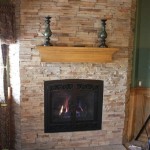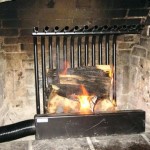Living Room Arrangement Ideas with Fireplace
A fireplace often serves as the focal point of a living room, influencing the room's layout and overall aesthetic. Arranging furniture around a fireplace requires careful consideration of factors such as room size, shape, traffic flow, and the intended use of the space. The goal is to create a comfortable, functional, and visually appealing environment that maximizes the fireplace's appeal while still meeting the needs of the occupants.
Successfully integrating a fireplace into a living room arrangement involves balancing symmetry and asymmetry, considering viewing angles for both the fireplace and any media devices, and optimizing the use of natural light. This article explores various living room arrangement ideas incorporating a fireplace, providing practical considerations and design principles to assist homeowners in creating an inviting and well-designed living space.
Creating a Focal Point: The Fireplace as the Center of Attention
When a fireplace is present, it naturally becomes the primary focal point. All other elements in the room should complement and enhance its presence rather than compete with it. This starts with recognizing the fireplace's architectural style and selecting furniture that harmonizes with it. For instance, a modern fireplace with clean lines might pair well with minimalist furniture, while a rustic stone fireplace benefits from more traditional and comfortable seating arrangements.
The placement of the main seating area is crucial. In many arrangements, the sofa is positioned directly facing the fireplace, allowing for unobstructed views and creating a sense of intimacy. Armchairs can then be placed on either side of the sofa, angled towards the fireplace to facilitate conversation and maintain visual balance. The distance between the seating and the fireplace should be proportionate to the room size; too close, and the space feels cramped; too far, and the fireplace loses its impact.
Accessories also play a crucial role in drawing attention to the fireplace. A well-chosen mantel display, incorporating items such as artwork, candles, or decorative objects, can enhance its visual appeal. A strategically placed area rug can define the seating area and further emphasize the fireplace as the room's center. Lighting, both natural and artificial, should be considered to highlight the fireplace and create a warm and inviting ambiance.
Balancing Form and Function: Optimizing Room Layout and Traffic Flow
Beyond aesthetics, a successful living room arrangement must prioritize functionality. This involves optimizing the room layout to allow for easy movement and facilitate various activities, such as conversation, relaxation, and entertainment. Traffic flow should be carefully considered to avoid disrupting the seating area or creating obstacles.
In smaller living rooms, maximizing space is paramount. One approach is to use smaller-scale furniture and avoid overcrowding the room. Wall-mounted shelving or built-in storage can provide functional storage without taking up valuable floor space. Consider using a sectional sofa instead of separate sofa and armchairs to provide ample seating while conserving space.
Larger living rooms offer more flexibility in terms of furniture arrangement. However, it's still important to maintain a sense of intimacy and avoid creating a cavernous and impersonal space. This can be achieved by dividing the room into distinct zones for different activities, such as a reading nook, a conversation area, and a media center. Area rugs can be used to visually define these zones and create a sense of cohesion.
Regardless of the room size, it's important to leave adequate space for walkways and to avoid obstructing pathways with furniture. A general rule of thumb is to allow at least three feet of clearance for main walkways. This ensures that people can move freely around the room without bumping into furniture.
If the living room also serves as a media room, the placement of the television becomes a critical consideration. Ideally, the television should be positioned in a way that minimizes glare and provides comfortable viewing angles from all seating positions. In some cases, this might involve placing the television above the fireplace, but this requires careful consideration of ergonomics and aesthetics. A more common approach is to place the television on a separate wall or in an entertainment center adjacent to the fireplace.
Addressing Common Challenges: Asymmetrical Fireplaces and Unique Room Shapes
Not all living rooms have perfectly symmetrical layouts or ideal fireplace placements. Asymmetrical fireplaces, such as those located in a corner or off-center on a wall, can present unique challenges when it comes to furniture arrangement. Similarly, oddly shaped rooms, such as those with angled walls or alcoves, can require creative solutions to maximize space and create a balanced layout.
When dealing with an asymmetrical fireplace, the key is to create a sense of balance through the strategic placement of furniture and accessories. Instead of trying to create perfect symmetry, embrace the asymmetry and use it to your advantage. For example, if the fireplace is located off-center, you can balance it by placing a large piece of artwork or a tall plant on the opposite side of the room. The use of varying heights and textures can also create visual interest and help to balance the room.
In oddly shaped rooms, it's important to work with the existing architecture rather than trying to fight it. Angled walls can be used to create interesting focal points or to define distinct zones within the room. Alcoves can be transformed into cozy reading nooks or used for storage. Custom-built furniture can be a valuable solution for maximizing space in oddly shaped rooms. By carefully planning the layout and selecting furniture that fits the space, it's possible to create a functional and stylish living room, even in the most challenging of spaces.
Another common challenge is integrating a fireplace into a modern, open-plan living space. In these cases, the fireplace might not be the sole focal point, and it's important to consider how it interacts with other elements in the room, such as the kitchen or dining area. One approach is to use the fireplace as a visual divider between different zones within the open-plan space. Another is to create a cohesive design scheme that incorporates the fireplace seamlessly into the overall aesthetic.
The choice of fireplace design itself can significantly impact the overall look and feel of the living room. Modern fireplaces often feature clean lines and minimalist designs, while traditional fireplaces might incorporate more ornate details and materials. The fireplace surround, mantel, and hearth can all be customized to complement the room's décor and create a cohesive design scheme. Natural stone, brick, and wood are popular materials for fireplace surrounds, offering a range of textures and colors to choose from. The mantel provides an opportunity to display decorative objects and artwork, adding personality and visual interest to the space. The hearth serves as a functional element, protecting the floor from heat and sparks, but it can also be a decorative feature in its own right.
Lighting plays a crucial role in enhancing the ambiance of a living room with a fireplace. Natural light should be maximized, allowing sunlight to stream into the room during the day. Large windows and skylights can help to brighten the space and create a sense of openness. Artificial lighting should be carefully planned to complement the natural light and create a warm and inviting atmosphere in the evening. Dimmable lights are a valuable option, allowing you to adjust the brightness to suit different moods and activities. Task lighting, such as floor lamps and table lamps, can provide focused light for reading or other activities. Accent lighting, such as spotlights and recessed lighting, can be used to highlight architectural features or decorative objects, adding depth and dimension to the room.
Ultimately, the best living room arrangement for a space with a fireplace depends on individual preferences, lifestyle, and the specific characteristics of the room. By carefully considering the principles of design, functionality, and personal style, homeowners can create a living space that is both beautiful and comfortable, maximizing the enjoyment of their fireplace and fostering a welcoming atmosphere for family and friends. The careful balance of aesthetics and practicality is the key to a successful and enduring living room design.
7 Inspirational Living Room Layout Ideas Heat Glo

7 Ways To Arrange A Living Room With Fireplace

Living Room Layouts With Fireplace Tvs Direct Fireplaces

11 Appealing Living Room Designs With A Fireplace

8 Designer Approved Living Room Layouts With A Fireplace Decorilla

7 Tips For Living Room Layouts With A Fireplace

How To Arrange A Living Room With Fireplace House Of Hipsters

Cabinet Around Fireplace Home Design Ideas S Remodel And Decor Living Room Livingroom Layout Arrangements

Top 15 Small Living Room With Fireplace And Tv Decorating Ideas Furniture Layout Corner Comfy Decor

How To Arrange A Living Room With Fireplace House Of Hipsters








